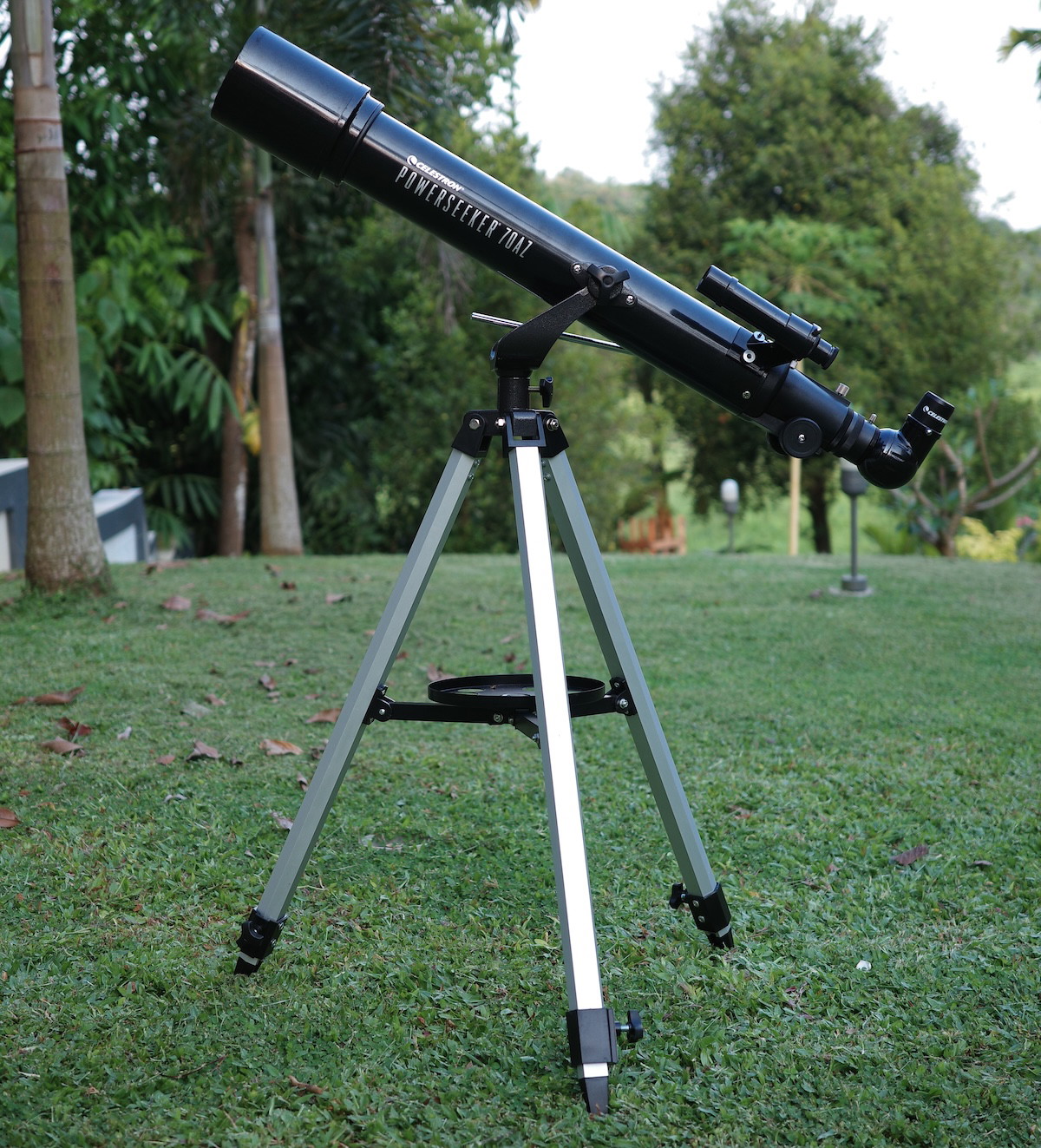Powerseeker 70AZ Optical Tube & Quality

The Celestron PowerSeeker 70’s optical tube is shared between the EQ and AZ versions and is thus identical. It’s a 70mm aperture achromatic refractor with a focal ratio of f/10.
Most of the parts on the OTA are plastic, but I don’t consider plastic to be necessarily bad quality on its own. Celestron has done a pretty good job of keeping the parts of the scope overall metal when they need to be. However, the same cannot be said for the accessories.
I kind of dislike the inside of the scope’s dew shield, which is shiny, hampering image contrast. However, I could relatively easily blacken it.
The images provided by this scope were surprisingly good when coupled with some of my own decent eyepieces. Sadly, the telescope does not come with any decent eyepieces. The rack-and-pinion focuser on the scope is also acceptable in quality, being 1.25″, which allows me to use decent eyepieces and accessories without trouble.
The Junk Accessories
Unlike some of the other PowerSeekers, which have severely deficient mounts or bad optics, I think the main killer of the Celestron PowerSeeker 70AZ is really its supplied accessories.
Unfortunately, by the time you replace all these accessories, you will have spent as much as, if not more than, the cost of the entire telescope. There are options for telescopes with better accessories at and above the PowerSeeker 70AZ’s price.
The PowerSeeker refractors all come with a 20mm Kellner eyepiece (45x), a 4mm Ramsden eyepiece (175x), and a junk 3x Barlow lens. Unlike refractors, PowerSeeker reflector scopes come with a 20mm erecting eyepiece instead of the 20mm Kellner.
In my testing, the 20mm Kellner was decent, but 45x is simply too much magnification for a 70mm telescope’s low-power eyepiece. The 4mm Ramsden already provides too much magnification for 70mm of aperture, and its narrow field of view and low quality don’t help. The 3x barlow is entirely plastic and is utterly useless as anything more than a dust cap.

The included diagonal is an Amici design, shaped like a handle after Celestron noticed that people tend to grab the diagonal as such during product testing. It works fine and presents me with correct left-right and up-down images for terrestrial viewing. However, this is not particularly useful for astronomical viewing and the Amici prism also absorbs light, making for a dimmer image at the eyepiece.
The 5×24 finderscope on the Celestron PowerSeeker 70AZ is also near-useless, being made entirely of plastic with a dim, narrow field of view and a bracket that is all-but-impossible to use to align the finder.

By the way, the scope also touts itself as coming with astronomy software. This software (I believe it’s TheSkyX Lite edition or something like that) is outdated and easily dispensed with by the free software, Stellarium.
The Mount with 70AZ

The Celestron PowerSeeker 70AZ’s mount is certainly not worthy of much in the way of praise from me, but it is not useless either.
The PowerSeeker 70AZ mount is an alt-azimuth fork design that works well for both terrestrial and astronomical purposes. There are no slow-motion controls, but the mount’s tension can be adjusted via small knobs, which works well enough. The aluminum tripod legs are small and thin, but I found them to be just adequate enough to support the whole scope.
Overall, the mount is not my favorite, but it works well enough.
Should I buy a used Celestron PowerSeeker 70AZ?
Unless it’s extremely cheap and you’re willing to deal with its shortcomings, a used Celestron PowerSeeker 70AZ is probably a waste of your time and money.
Alternative Recommendations
If you’re looking for a better scope than the PowerSeeker 70AZ but have a budget of $150 or below, there are a number of superior options:
- The SarBlue Mak70 has the same aperture as the 70AZ, sharper parabolic optics, decent included accessories, and is stable and easy to aim.
- The Celestron FirstScope provides relatively fuzzy views due to its flawed optics, but it’s easier to use and more stable than the 70AZ.
For finding more options, we recommend you check out our Telescope Ranking page.
Aftermarket Accessory Recommendations
Upgrading the Celestron PowerSeeker 70AZ is probably not worth the expense and hassle. You’d be better off saving your money for a different, and preferably larger/better, telescope.
Observing with the Celestron PowerSeeker 70AZ
The Celestron PowerSeeker 70AZ’s small aperture limits its ability to show us much besides the Moon, planets, double stars, and a handful of the brightest deep-sky objects.
The Moon shows a wealth of details, and I can view the phases of Venus and the ice caps of Mars. Jupiter’s cloud belts and the Great Red Spot (as well as the giant planet’s moons) are visible along with Saturn’s moons, rings, and maybe a hint of its cloud belts or the Cassini Division in its rings.
Outside the solar system, we are again severely limited simply by the telescope’s small size (as well as the lack of an adequate finderscope).
The Andromeda Galaxy is visible as a fuzz, as well as a few other galaxies with some difficulty. Globular clusters are all smudges. A fair amount of open star clusters are mildly interesting, as are some double stars, but don’t expect anything eye-popping, especially if you don’t have pristine dark skies.



